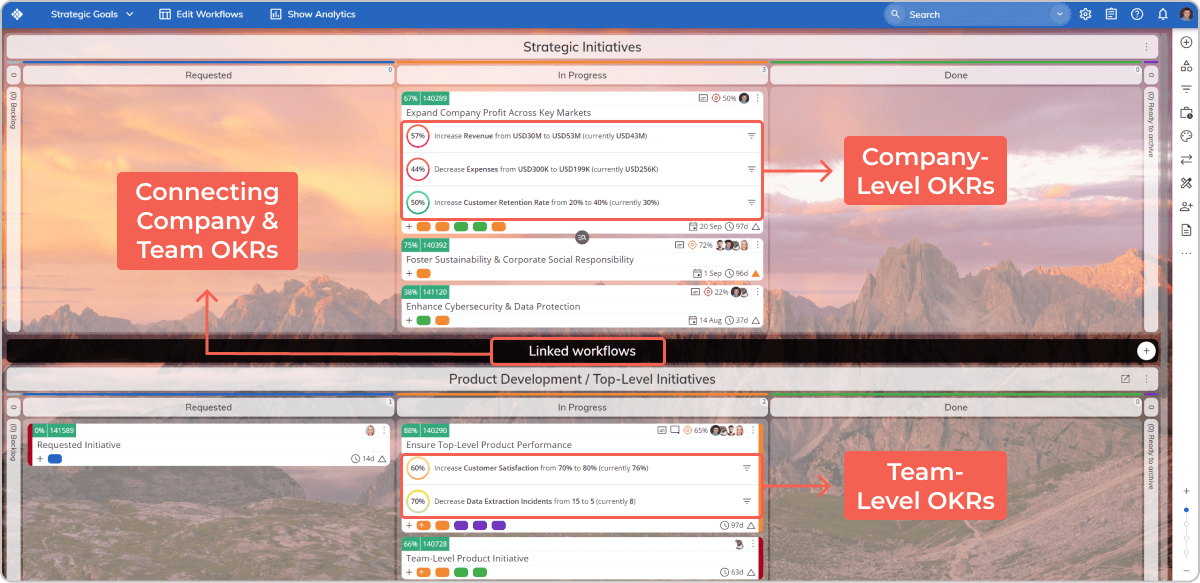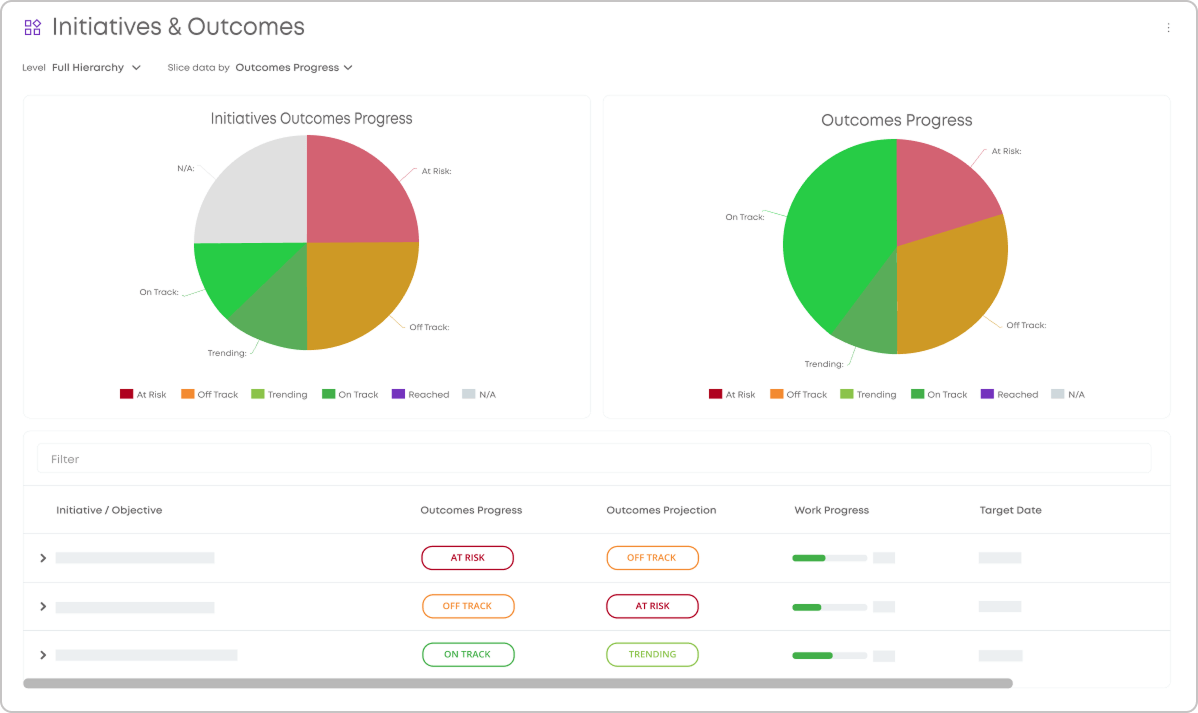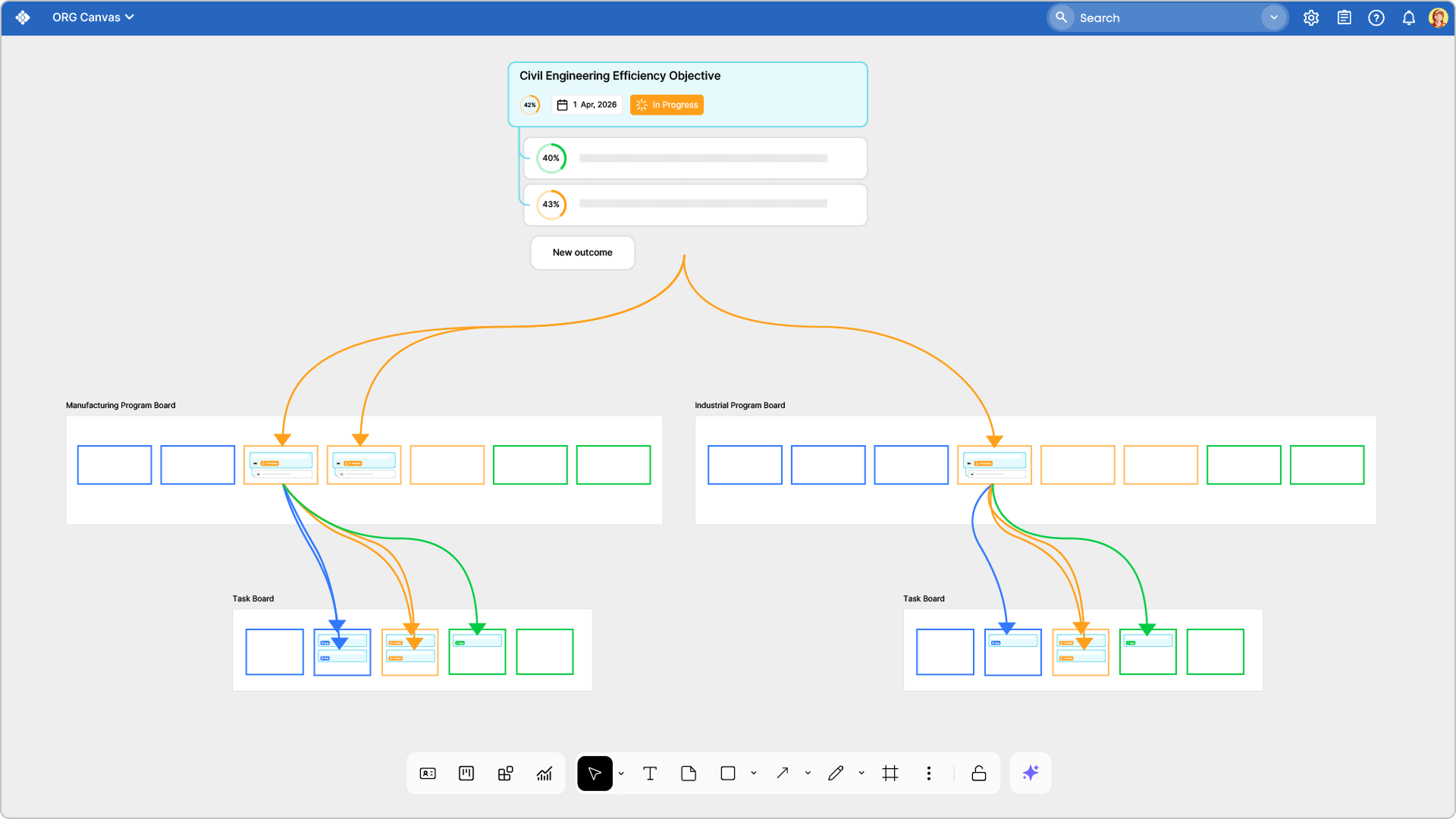What Is a Project and Portfolio Risk Management Software?
Project and portfolio risk management software is a digital system for identifying, analyzing, mitigating, and monitoring risks across multiple projects and portfolios. They help leaders assure risks are not managed in isolation but in the context of their strategic goals and interdependencies.
At its core, PPRM software supports four capabilities:
-
Centralized risk visibility: Unified risk dashboards show exposure across initiatives.
-
Alignment with strategic goals: Risks are evaluated through the lens of portfolio value and ROI, not just urgency.
-
Predictive analytics: Heatmaps, probability forecasts, and scenario planning capabilities to reveal how risks evolve.
-
Governance and standards: Standardizing via policies ensures consistent risk handling across teams.
This aligns strongly with the principles of effective project portfolio management, which emphasize doing the right projects, optimizing resource use, and maintaining strategic alignment.
 Visualizing the link between company-level objectives and team-level goals in Businessmap
Visualizing the link between company-level objectives and team-level goals in Businessmap
Key Features of Top Risk Management Software Solutions
The strongest project and portfolio risk management solutions share several defining capabilities:
Centralized, Multi-Level Risk Views
A consolidated view of risks across:
Having a unified view helps keep important risk information accessible to everyone and makes it easy to know who to turn to when issues arise.
Dashboards and Risk Heatmaps
Visualizations that show:
- likelihood vs. impact
- exposure across portfolios
- emerging risk trends
- team or domain-specific concentrations of risk
Heatmaps help leaders easily identify areas where risks could impact their goals.
Scenario Planning and Portfolio Simulation
"What happens if"
- capacity drops in a critical team
- market or regulatory changes impact timelines
- a high-value initiative falls behind
Scenario modeling techniques encourage people to act proactively, and with AI capabilities, you get a more robust detection and simulation of such scenarios.
Governance, Policies & Audit Readiness
Compliance with frameworks such as:
- ISO 31000
- COSO ERM
- SOX
- NIST
Key capabilities include approval workflows, audit logs, permissions, and standard risk-handling policies.
Deployment Flexibility
Depending on security requirements:
- Cloud-based deployment widely used for speed and scalability
- On-premises deployment for regulated industries or strict data privacy needs
Executive Reporting & Alerts
Automated insights for leadership, including:
- risk exposure summaries
- KPI dashboarding
- trend reports
- alerts when thresholds are exceeded
 An executive dashboard with OKRs/KPIs and other important metrics in Businessmap
An executive dashboard with OKRs/KPIs and other important metrics in Businessmap
Integration with Existing Work Systems
Modern PPRM tools typically integrate with:
- ERP systems
- BI tools
- Jira
- Azure DevOps
This ensures risk insights flow directly from real project execution data, which means less need for manual entry and greater accuracy.
How to Choose a Project Portfolio Risk Management Software
Use these criteria when selecting a PPRM solution:
1. Strategic Fit
Does the tool support the way your organization makes decisions?
For example, PPM highlights strategic alignment, resource optimization, and governance, and your PPRM tool should give you the full picture too.
2. Level of Risk Analysis
Evaluate whether the tool supports:
Strong data collection and analytics are non-negotiable.
3. Visualization Capabilities
Verify that your teams can:
- visualize risk by portfolio, program, project, or outcome
- track risk probability, severity, and trend over time
- link risks to dependencies and workflow stages
The more visual the system, the easier it is to spot an issue and act quickly.
 Visualizing how a strategic goal is connected to program portfolio initiatives and team execution using AI canvas in Businessmap
Visualizing how a strategic goal is connected to program portfolio initiatives and team execution using AI canvas in Businessmap
4. Integration With PM & Engineering Systems
Your tool should automatically import work status. Manual updates kill adoption.
5. Governance & Audit Controls
Risk management practices must be steady and reliable.
6. Scalability & Usability
Think about whether the tool can grow and adapt to your needs:
- Can it support hundreds or thousands of users?
- Can it handle multiple portfolios?
- Is the UI intuitive enough for non-technical stakeholders?
7. Value for Money
Consider:
- total cost of ownership
- implementation packages
- training availability
- ongoing support
A great tool is only valuable if people actually use it.
What Are the Leading Project and Portfolio Risk Management Software?
1. Businessmap
Businessmap is a flexible, enterprise-ready PPM platform that integrates strategy execution, portfolio visualization, and operational risk management into a single system. Its strengths lie in real-time transparency, advanced analytics, and the potential to scale horizontally and vertically across large organizations. This makes it well-suited for companies seeking both control and agility in their project portfolios.
Key PPM & Risk Management Capabilities
-
End-to-End Portfolio Visibility: provides a unified view of all initiatives, from strategic projects to day-to-day work, using interconnected work boards and customizable workflows.
-
Risk Identification: visualizing risks using explicit Risk Management levels, blockers, flags, and policy-driven signals.
-
Strategic-to-Operational Alignment: allows the use of OKR-level boards, linked workflows, and Flight Levels implementation.
-
Dependency and Capacity Management: supports visualization of cross-team dependencies, resource constraints, and service workflows.
-
Portfolio-Level Analytics: offers performance dashboards to identify bottlenecks, evaluate delivery risks, and forecast outcomes based on historical performance.
-
Policies & Compliance Alignment: process policies are embedded directly into workflows.
Here's how to track and manage risks with а PPM software like Businessmap.
Pricing & Availability
-
Pricing Model: subscription-based, from $8 per 100 users (when billed annually)
-
Free Trial: 14 days, pre-recorded demos, product tour
-
Support: Customer onboarding, implementation and integration packages available
-
Integrations: Power BI, MS Teams, Tableau, GitHub, Zapier, Rest API
-
Training: Webinars, documentation, onboarding sessions, and enterprise consulting, training programs
Ready to see Businessmap in action?
2. Celoxis
Celoxis offers strong PPM fundamentals, including portfolio visibility, scheduling, resource management, and data-driven reporting. In addition, it offers moderate risk management capabilities and AI-powered forecasting. It is a solid choice for organizations seeking a balanced, all-in-one PPM tool for both Agile and traditional delivery.
PPM & Risk Management Capabilities
- Interactive Gantt charts, cross-project timelines, and customizable reports allow PMOs to track progress and detect risks early.
- Built-in risk registers, issue tracking, and customizable fields for probability/impact scoring.
- Integration with LEX AI improves risk forecasts by analyzing historical performance data and surfacing early-warning signals.
- Capacity planning, workload tracking, and resource distribution charts.
- Budgeting, cost tracking, and revenue forecasting.
Pricing & Availability
-
Free Trial: 14 days
-
Cloud Pricing: Starting at $10/user/month (Core) up to $45/user/month (Business, billed annually, 5-user minimum); Custom plan available for large teams
-
On-Premise: Custom licensing options
-
Training: Webinars, documentation, onboarding sessions, and enterprise consulting
-
Support: Community support, standard (3-day response time), 1-day response time, and chat support available with the highest-level plans (Business and Enterprise)
-
Integrations with Zapier, Jira, Azure DevOps, QuickBooks included in the highest-level plan and as an add-on with any plan
3. Apptio Targetprocess
Targetprocess is a highly visual enterprise work management platform for enterprises seeking strong visual portfolio management, dependency mapping, and scaled Agile support. It is particularly well-suited for organizations operating within SAFe or hybrid delivery environments that require deep coordination and clear visualization across teams.
PPM & Risk Management Capabilities
- Multi-level portfolio structures that connect objectives, value streams, epics, features, and team-level work
- Planned vs actual risk dashboards, custom, automatic notifications
- Visualization capabilities for cross-team dependencies and risk relationships
- Agile, SAFe & hybrid workflows support
- What-if scenarios, and investments reprioritization based on capacity and strategic objectives
Pricing & Availability
- Quotes based on org size and needs
- Free trial available
-
Training: Tutorials, expert guidance, and certification programs
-
Support: Tiered support options including standard Enterprise Success (12x5 personalized assistance), and Premier Success add-on (24x7 support, enhanced SLAs, and dedicated product mentoring).
-
Integrations: Connects with enterprise tools across planning, DevOps, and reporting ecosystems
4. Oracle Primavera P6 Enterprise Project Portfolio
Oracle Primavera is a well-established platform for complex project and portfolio management, delivering strong scheduling, cost control, and risk analysis capabilities. It is particularly powerful for organizations managing long, interdependent projects with strict compliance constraints.
PPM & Risk Management Capabilities
- Unified environment for planning, prioritizing, executing, and monitoring projects and programs.
- Critical path method (CPM) scheduling engine, enabling leaders to model detailed task structures, analyze path deviations, and identify timing-related risks.
- Integrated risk registers, qualitative assessments, probability-impact scoring.
- Risk analysis via charts, Gantt visualizations, and scenario models.
- End-to-end resource tracking.
- Dashboards, KPIs, configurable reports to evaluate project health, risk exposure, and variance trends.
Pricing & Availability
- Subscription (monthly/annual) with optional perpetual licensing
-
Deployment: Cloud or on-premise
-
Training: Documentation, enterprise training, partner-led implementation
-
Trial: Interactive demo available
| |
Risk Management Capabilities |
Trial |
Pricing |
| Businessmap |
Blockers, flags, and policy-driven signals
Workflow policies
Executive dashboards showing initiatives’ progress and trends
|
14-day trial, product tour, pre-recorded demos |
From $8 per 100 users/month (annual billing)
Custom plans available for large organizations
|
| Celoxis |
Built-in risk registers
Probability/impact scoring
AI-enhanced forecasting via LEX AI
|
14-day trial
|
Cloud: $10 - $45/user/month (billed annually)
On-Premise: Custom licensing options
|
| Apptio Targetprocess |
Planned vs. actual risk dashboards
Visualization of risk relationships
Automatic notifications
|
Free trial upon request |
Custom pricing |
| Oracle Primavera P6 |
Integrated risk registers
Qualitative & probability-impact analysis
Schedule risk analysis & scenario modeling
|
Self-guided demo
Online training library
|
Subscription (monthly/annual) |
5 Risk Management Practices [Expert Advice]
Effective portfolio-level risk management is about adopting the right practices that make risks visible, measurable, and actionable. Here are five key practices shared by Teodora Bozheva, a leading expert in project management and enterprise agility with 18+ years of experience in improving work ways and process efficiency in large organizations.
1. Visualize Risks on Portfolio Boards
Transparency is your first line of defense.
Visualize:
- blockages
- accumulated work-in-progress
- waiting times
- supplier or customer-related delays
- defects and unexpected events
When risks are visible, teams address them faster and stakeholders collaborate more effectively.
 Using visual signals to indicate work interruptions in Businessmap
Using visual signals to indicate work interruptions in Businessmap
2. Use Flow Data to Estimate Deadlines More Accurately
Teams often underestimate timelines because they rely on intuition instead of data.
Flow metrics like cycle time, WIP, and throughput provide:
- historical benchmark data
- realistic forecasting
- insight into causes of delay
This directly reduces one of the biggest risks in project portfolios: late delivery.
3. Make Project Status Constantly Visible
Stakeholders should not need to request updates.
When they see real-time status:
- alignment improves
- expectations become realistic
- collaboration increases
Visibility plays a key role in reducing the downstream impact of risks that would otherwise go unnoticed.
4. Visualize Dependencies Between Projects
Dependencies are one of the biggest sources of portfolio risk.
Mapping them helps leaders:
- prioritize work
- protect critical paths
- allocate resources more intelligently
In complex portfolios, dependency visualization is essential for risk mitigation.
5. Apply Workflow Policies Consistently
Aligned policies enable consistent decision-making across teams and functions.
Policies should reflect:
- organizational capacity
- risk tolerance
- cost of delaying work
Consistency in policy application will help you prevent confusion and reduce systemic risks.
FAQs
What platforms offer enterprise-grade risk management solutions for project portfolios?
Enterprise PPRM solutions typically include:
- centralized risk boards
- cross-portfolio heatmaps
- scenario modeling
- governance frameworks
- integrations with key delivery systems
Businessmap is the most comprehensive option for organizations seeking hybrid management with connected portfolio-level risk management, while others excel in more traditional or Agile contexts.
Are there industry-specific risk management platforms tailored for IT, manufacturing, or consulting?
Yes. While many PPRM tools are industry-agnostic, each platform tends to align with specific operational environments:
- Businessmap is widely adopted across engineering, financial, hardware R&D, consulting, IT, software development, and any environment that requires fast flow, cross-team alignment, compliance visibility, or complex dependency management. Its flexibility makes it suitable for both digital and physical product organizations.
- Celoxis is often chosen by IT, consulting, and professional service organizations that rely on structured project planning and financial tracking.
- Apptio Targetprocess is strong in IT, technology, and organizations implementing SAFe, LeSS, or hybrid Agile frameworks, where tracking dependencies and coordinating Agile teams is critical.
- Oracle Primavera is most prevalent in construction, engineering, infrastructure, energy, aerospace, and large capital programs, where CPM scheduling and cost-risk analysis are essential.
Which PPRM software vendors integrate with Jira and Azure DevOps?
Most modern PPRM platforms integrate with Jira and ADO, but the depth of integration varies. For supported, real-time synchronization of Agile work with portfolio insights, Businessmap and Targetprocess offer the most robust integration experience.
Which PPRM tools support compliance frameworks and governance policies?
If compliance, audit readiness, and policy consistency are strategic priorities, Businessmap and Oracle Primavera provide the strongest governance capabilities, with Businessmap offering more flexibility and visibility for fast-moving digital environments.
Discover how Businessmap supported real-time visualization of quality management policies, helping a global manufacturer pass its ISO 9001 audit with strong results. Read case study →
Which portfolio tools provide integrated risk and return metrics?
- Businessmap is the most comprehensive option for organizations seeking a hybrid management approach with connected portfolio risk intelligence. It offers portfolio-level analytics that connect risk and outcome by providing performance dashboards to identify bottlenecks, evaluate delivery risks, and forecast outcomes based on historical performance.
- Celoxis integrates its risk register and AI-enhanced forecasting (via LEX AI) with financial metrics through capabilities like budgeting, cost tracking, and revenue forecasting, comparing actual expenses against planned budgets.
- Oracle Primavera provides strong risk analysis alongside features for cost control and real-time reports to evaluate project health, risk exposure, and variance trends. Primavera Analytics add-on enables users to create operational reports on their projects and programs.
Ready to see Businessmap in action?





 Visualizing the link between company-level objectives and team-level goals in Businessmap
Visualizing the link between company-level objectives and team-level goals in Businessmap An executive dashboard with OKRs/KPIs and other important metrics in Businessmap
An executive dashboard with OKRs/KPIs and other important metrics in Businessmap Visualizing how a strategic goal is connected to program portfolio initiatives and team execution using AI canvas in Businessmap
Visualizing how a strategic goal is connected to program portfolio initiatives and team execution using AI canvas in Businessmap Using visual signals to indicate work interruptions in Businessmap
Using visual signals to indicate work interruptions in Businessmap

